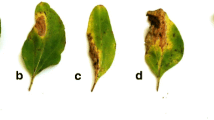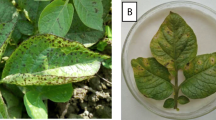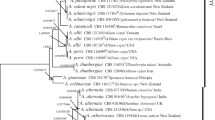Abstract
Sweet cherry leaf spot, caused by Alternaria spp., causes significant yield losses to sweet cherry production globally. This study was aimed at morphological and molecular identification of the causal agent, Alternaria spp., of leaf spot disease on sweet cherry in the Usak province, Turkey. Isolates were also tested for pathogenicity. In April–June in 2018 and 2019, the sampling was conducted in a total of 84.4 hectares in 70 orchards that were selected to represent the province of Uşak where the highest sweet cherry farming takes place. In the first year, the incidence of Alternaria spp. was highest in the Central district (31.8%) while in the second year high incidences were found in Central (50%), Esme (33.3%) and Banaz (26.9%) districts. The isolated Alternaria spp. was identified based on morphological and microscopic characteristics. Pathogenicity tests were conducted for all isolates based on Koch’s postulates and were made on cultivar Ziraat 0900 of sweet cherry in the climate chamber conditions. The phylogenetic analysis using sequences of the internal transcribed spacer region of the ribosomal RNA (ITS rRNA), translation elongation factor (TEF) and RNA polymerase II subunit (RPB2) genes showed that our isolates clustered in the same branch with reference isolates of A. alternata. This study is the first report of A. alternata causing of leaf spot disease of sweet cherry in Turkey.




Similar content being viewed by others
References
Ahmad T, Liu Y, Moosa A, Farzand A, Zhao Y, Wang G (2019) First report of Alternaria alternata causing postharvest fruit rot of Syzygium cumini (Jamun) in Pakistan. Plant Dis 103(10):2693
Ahmad T, Liu Y, Shujian H, Moosa A (2020) First record of Alternaria alternata causing postharvest fruit rot of sweet cherry (Prunus avium) in China. Plant Dis 104(7):2030
Anonymous (2020) Kiraz değerlendirme raporu. T.C Tarım ve Orman Bakanlığı
Armitage AD, Barbara DJ, Harrison RJ, Lane CR, Sreenivasaprasad S, Woodhall JW, Clarkson JP (2015) Discrete lineages within Alternaria alternata species group: Identification using new highly variable loci and support from morphological characters. Fungal Biol 119(11):994–1006
Basım E, Basım H, Abdulai M, Baki D, Oztürk N (2017) Identification and characterization of Alternaria alternata causing leaf spot of olive tree (Olea europaea) in Turkey. Crop Prot 92:79–88
Carbone I, Kohn LM (1999) A method for designing primer sets for speciation studies in filamentous ascomycetes. Mycologia 91:553–556
Chen YJ, Meng Q, Zeng L, Tong HR (2018) Phylogenetic and morphological characteristics of Alternaria alternata causing leaf spot disease on Camellia sinensis in China. Australas Plant Pathol 47:335–342
Chethana K, Jayawardene R, Zhang W, Zhou Y, Liu M, Hyde K, Li X, Wang J, Zhang K, Yan J (2019) Molecular characterization and pathogenicity of fungal taxa associated with cherry leaf spot disease. Mycosphere 10(1):490–530
Choi MO, Kim SG, Hyun IH, Kim JH, Cho CH, Park MS, Kim YH (2010) First report of black spot caused by Alternaria alternata on grafted cactus. Plant Pathol J 26(1):80–82
Choi SH, Kim DS, Kozukue N, Kim HJ, Nishitani Y, Mizuno M, Levin CE, Friedman M (2014) Protein, free amino acid, phenolic, β-carotene, and lycopene content, and antioxidative and cancer cell ınhibitory effects of 12 greenhouse-grown commercial cherry tomato varieties. J Food Compos Anal 34(2):115–127
Fang P, Shi S, Liu X, Zhang Z (2020) First report of Alternaria black spot of rose caused by Alternaria alternata in China. J Plant Pathol 102:273. https://doi.org/10.1007/s42161-019-00411-6
FAO (2020) Food and Agricultural Organization. Retrieved 20/11/2020, from http://www.fao.org/faostat/en/#data/QC
Farr D, Rossman A (2013) Fungal databases. Systematic mycology and microbiology laboratory. In: Online publication. ARS: USDA.
Felsenstein J (1985) Confidence limits on phylogenies: an approach using the bootstrap. Evolution 39:783–791
Fungorum I (2018) Index fungorum base de datos. Disponible en: Disponible en: http://www.indexfungorum.org/names/names.asp
Gannibal PB, Orina AS, Mironenko NV, Levitin MM (2014) Differentiation of the closely related species, Alternaria solani and A. tomatophila, by molecular and morphological features and aggressiveness. Eur J Plant Pathol 139(3):609–623. https://doi.org/10.1007/s10658-014-0417-6
Guindon S, Dufayard JF, Lefort V, Anisimova M, Hordijk W, Gascuel O (2010) New algorithms and methods to estimate maximum-likelihood phylogenies: assessing the performance of PhyML 3.0. Syst Biol 59:307–321
Holb I (2008) Brown rot blossom blight of pome and stone fruits: symptom, disease cycle, host resistance, and biological control. Int J Hortic Sci 14(3):15–21
Huelsenbeck JP, Ronquist F (2001) MRBAYES: Bayesian inference of phylogenetic trees. Bioinformatics 17:754–755
Joshua J, Mmbaga MT (2015) Perpetuation of cherry leaf spot disease in ornamental cherry. J Phytopathol 163(3):194–201
Karaca İ (1972) Kemalpaşa Bölgesinde Kiraz Ağaçlarının Kuruma Sebepleri Üzerinde Araştırmalar. TBTAK
Kumar S, Stecher G, Tamura K (2016) Molecular evolutionary genetics analysis version 7.0 for bigger datasets. Mol Biol Evol 33(7):1870–1874
Laich FS, Alcoba-Flórez J, Pérez-Roth E, Bahaya Y, Luis Delgado J, Méndez-Álvarez S (2008) Molecular characterization of Alternaria alternata causing ocular infection: detection of IGS-RFLP intraspecific polymorphism. Sabouraudia 46(6):615–619
Lawrence DP, Gannibal PB, Peever TL, Pryor BM (2013) The sections of Alternaria: formalizing species-groups concepts. Mycologia 105:530–546
Lawrence DP, Rotondo F, Gannibal PB (2016) Biodiversity and taxonomy of the pleomorphic genus Alternaria. Mycology Progress 15:3
Liu YJ, Whelen S, Hall BD (1999) Phylogenetic relationships among ascomycetes: evidence from an RNA polymerse II subunit. Mol Biol Evol 16:1799–1808
Loganathan M, Venkataravanappa V, Saha S, Rai AB, Tripathi S, Rai RK (2016) Morphological, pathogenic and molecular characterizations of Alternaria species causing early blight of tomato in Northern India. Proc Natl Acad Sci India B Biol Sci 86(2):325–330
Long H, Yang S, Yin X, Zhao Z, Long Y, Fan J, Shu R, Gu G (2021) First report of leaf spot on Prunus salicina caused by Alternaria alternata in China. J Plant Pathol 103:1021
Maiti CK, Sen S, Acharya R, Acharya K (2007) First report of Alternaria alternata causing leaf spot on Stevia rebaudiana. Plant Pathol 56:723
Mmbaga MT, Shi A, Kim MS (2011) Identification of Alternaria alternata as a causal agent for leaf blight in syringa species. Plant Pathol J 27(2):120–127
Moosa A, Ahmad T, Khan SA, Gleason ML, Farzand A, Safdar H, Ali MA (2019) First report of Alternaria alternata causing postharvest brown spot of plums (Prunus domestica) in Pakistan. Plant Dis 103(7):1767–1767
Nei M, Kumar S (2000) Molecular evolution and phylogenetics. Oxford University Press, New York
Ogawa JM, English H (1991) Diseases of temperate zone tree fruit and nut crops. UCANR Publications
Prusky D (1996) Pathogen quiescence in postharvest diseases. Ann Rev Phytopathol 34:413–434
Pryor BM, Gilbertson RL (2000) Molecular phylogenetic relationships amongst Alternaria species and related fungi based upon analysis of nuclear ITS and mtSSU rDNA sequences. Mycol Res 104:1312–1321
Pryor BM, Michailides TJ (2002) Morphological, pathogenic, and molecular characterization of Alternaria ısolates associated with Alternaria late blight of pistachio. Phytopathology 92(4):406–416
Rotem J (1998) The genus of Alternaria: Biology, Epidemiology and Pathogenicity. The American Phytopathological Society, USA, pp. 326
Rotondo F, Collina M, Brunelli A, Pryor BM (2012) Comparison of Alternaria spp. collected in Italy from apple with A. mali and Other AM-toxin producing strains. Phytopathology 102(12):1130–1142
Simmons EG (2007) Alternaria: An Indentification Manual. CBS Biodiversity Series 6. CBS Fungal Biodiversity Centre, Utrecht, The Netherlands
Stewart JE, Timmer LW, Lawrence CB, Pryor BM, Peever TL (2014) Discord between morphological and phylogenetic species boundaries: incomplete lineage sorting and recombination results in fuzzy species boundaries in an asexual fungal pathogen. BMC Evol Biol 14(1):38
Sung GH, Sung JM, Hywel-Jones NL, Spatafora JW (2007) A multi-gene phylogeny of Clavicipitaceae (Ascomycota, Fungi): Identification of localized incongruence using a combinational bootstrap approach. Mol Phylogenet Evol 44:1204–1223
Thomidis T, Tsipouridis C (2006) First report of Alternaria leaf spot on cherry trees in Greece. Plant Dis 90(5):680–680
Uyemoto JK, OJ, Jaffee, BA (2018) Common names of plant diseases: diseases of sweet cherry (Prunus avium L.) and sour cherry (P. cerasus L.). The American Phytopathological Society
Ülkümen L (1973) Bağ-Bahçe Ziraati. Atatürk Üniv Ziraat Fak., Yay:275.
Wang T, Zhao J, Sun P, Wu X (2014) Characterization of Alternaria species associated with leaf blight of sunflower in China. Eur J Plant Pathol 140(2):301–315
Woudenberg J, Groenewald J, Binder M, Crous P (2013) Alternaria redefined. Stud Mycol 75:171–212
Woudenberg JHC, Seidl MF, Groenewald JZ, de Vries M, Stielow JB, Thomma BPHJ, Crous PW (2015) Alternaria section Alternaria: species, formae speciales or pathotypes? Studies Mycol 82:1–21
You M, Lanoiselet V, Wang C, Barbetti M (2014) First report of Alternaria leaf spot caused by Alternaria tenuissima on blueberry (Vaccinium corymbosum) in Western Australia. Plant disease 98(3):423–423
Zhu J, Chang Y (2004) Cherry black ring spot pathogen identification and biological study (in Chinese). China Fruits 3:9–12
Author information
Authors and Affiliations
Contributions
This work is a part of AŞ’s MSc study. HD contributed to conception and design, and AŞ and HD collected the samples and surveyed from orchard and performed laboratory work. AUM performed molecular analysis. HD and AUM analysed the data and wrote the manuscript. All authors read and approved the final manuscript.
Corresponding author
Ethics declarations
Conflict of interest
The authors declare that they have no conflict of interest.
Additional information
Publisher's Note
Springer Nature remains neutral with regard to jurisdictional claims in published maps and institutional affiliations.
Rights and permissions
Springer Nature or its licensor holds exclusive rights to this article under a publishing agreement with the author(s) or other rightsholder(s); author self-archiving of the accepted manuscript version of this article is solely governed by the terms of such publishing agreement and applicable law.
About this article
Cite this article
Şimşek, A., Dinler, H. & Uysal Morca, A. Identification and pathogenicity of Alternaria alternata causing leaf spot disease on sweet cherry in Province of Turkey. J Plant Dis Prot 129, 1355–1366 (2022). https://doi.org/10.1007/s41348-022-00648-x
Received:
Accepted:
Published:
Issue Date:
DOI: https://doi.org/10.1007/s41348-022-00648-x




